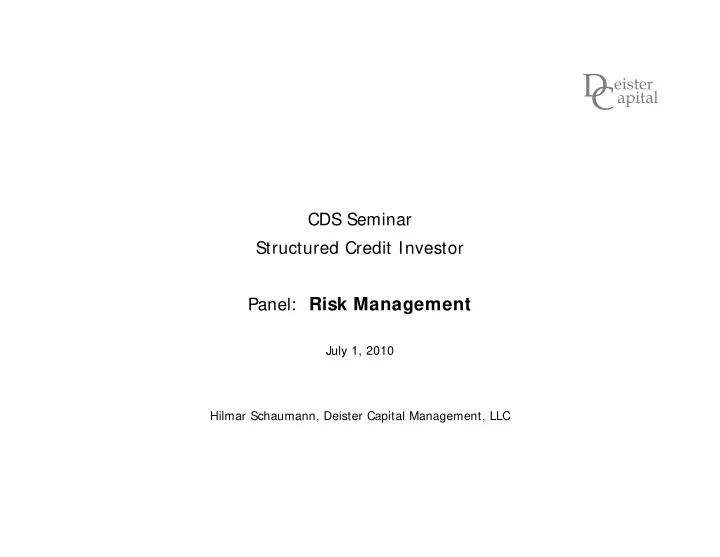

D eister C apital C apital CDS Seminar St Structured Credit Investor t d C dit I t Panel: Risk Management g July 1, 2010 Hilmar Schaumann, Deister Capital Management, LLC
CDS Clearing CM Clearing System CM CM Futures Subsidiary of Hedge Futures Bank B Fund Subsidiary of Bank A Bank A CM CM CM Regional CM B Bank k 1. Hedge Fund buys default protection from his Clearing Member / Futures Commission Merchant, which is a clearing member of the clearing system / exchange / Central Counterparty which is a clearing member of the clearing system / exchange / Central Counterparty. 2. The other side of the trade is ultimately taken by Regional Bank, which sells default protection to its clearer. 3. The two clearing members match their trades, and the two clearing members are being g , g g substituted by the Clearing System as counterparty Hilmar Schaumann, Deister Capital Management, LLC 6/30/2010 2
Counterparty Risk • Primary counterparty risk is between Hedge Fund and his clearing member – Different from status quo: (i) Clearing member is perfectly hedged by definition and the customer account is segregated; (ii) clearing member is scrutinized by Clearing System; (iii) clearing member may be a less capitalized subsidiary of a bank – If the hedge fund defaults, it is his clearing member’s problem; clearing member is responsible versus the Clearing System for his clients’ obligations – Protection of customer accounts may not always be complete (e g in case another customer defaults) Protection of customer accounts may not always be complete (e.g. in case another customer defaults). So, So the customer faces a certain counterparty credit exposure versus its clearing member. • Second line of defense: If the clearing member defaults, – Transfer segregated customer positions and monies to another clearing member – Transfer segregated customer positions and monies to another clearing member – Take over or liquidate positions – Apply clearing member’s guarantee fund • Remarks: k – ICE’s clearing members are the 14 banks, not Futures subsidiaries – The purpose of the reserve funds and of transferring positions and monies is to protect the system, not the individual customer Hilmar Schaumann, Deister Capital Management, LLC 6/30/2010 3
Risk Managing a Credit Portfolio • Credit portfolio may be a loan book, bond portfolio or counterparty risk • Establish risk framework • Establish risk framework – Concentration limits (single names, industries, geography) – Avoid negative tail risk by keeping long positions highly diversified • Reduce peak exposures by buying default protection on these credits via single-name CDS • Utilize the asymmetry of credit risk by establishing concentrated short positions in vulnerable credits – Apply fundamental credit analysis Apply fundamental credit analysis – These short picks are not necessarily components of the long book – Portfolio assumes a long volatility risk profile and is better protected against tail events • If spending accruals on shorts is a problem, establish additional longs via indices or p g p , g through a group of small individual positions in credits that provide additional diversification (e.g. from a different geographic region or different sectors) Hilmar Schaumann, Deister Capital Management, LLC 6/30/2010 4
I mpact of FinReg on Liquidity of CDS • Uncertainty about the product is largely gone y p g y g • Clearing and price transparency are considered very positive • Investment grade CDS can stay with banks • Capital requirements will determine what leverage is possible p q g p • Can CDS overtake bonds again? The flexibility of the product should help it succeed. Hilmar Schaumann, Deister Capital Management, LLC 6/30/2010 5
Contact Hilmar Schaumann Deister Capital Management, LLC 330 Madison Avenue, Suite 643 New York NY 10017 New York, NY 10017 Tel. + 1 (646) 366-5101 hschaumann@deistercapital.com Deister Capital Management, LLC 6/30/2010 6
Recommend
More recommend